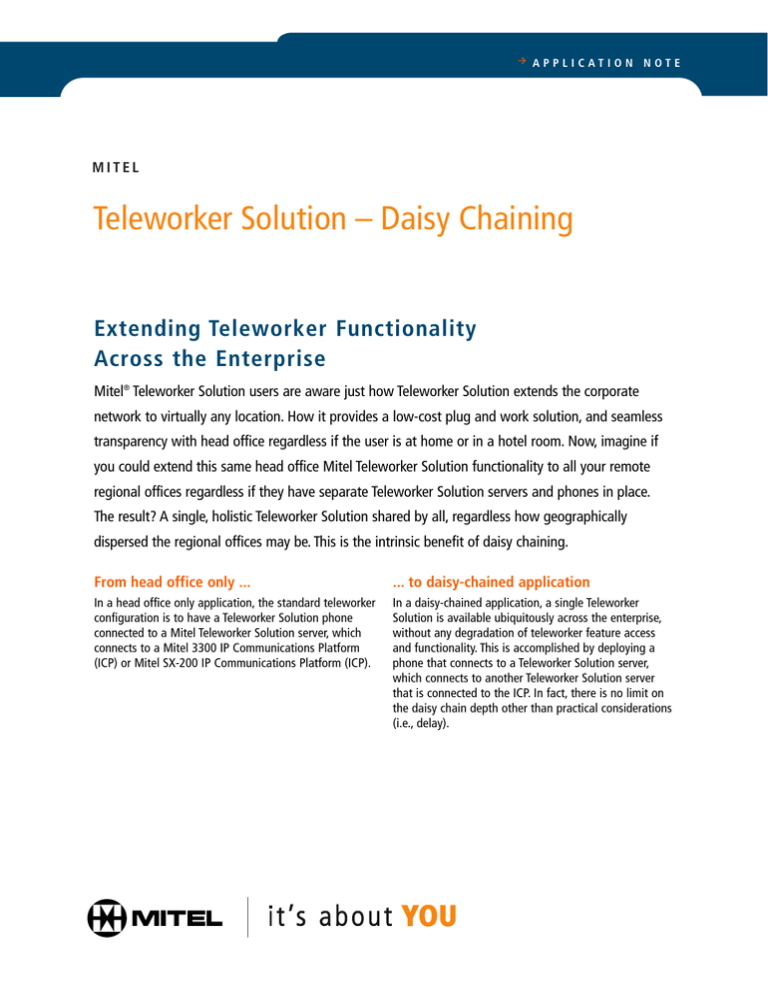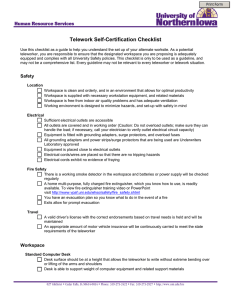
APPLICATION NOTE
MITEL
Teleworker Solution – Daisy Chaining
Extending Teleworker Functionality
Across the Enterprise
Mitel® Teleworker Solution users are aware just how Teleworker Solution extends the corporate
network to virtually any location. How it provides a low-cost plug and work solution, and seamless
transparency with head office regardless if the user is at home or in a hotel room. Now, imagine if
you could extend this same head office Mitel Teleworker Solution functionality to all your remote
regional offices regardless if they have separate Teleworker Solution servers and phones in place.
The result? A single, holistic Teleworker Solution shared by all, regardless how geographically
dispersed the regional offices may be. This is the intrinsic benefit of daisy chaining.
From head office only ...
... to daisy-chained application
In a head office only application, the standard teleworker
configuration is to have a Teleworker Solution phone
connected to a Mitel Teleworker Solution server, which
connects to a Mitel 3300 IP Communications Platform
(ICP) or Mitel SX-200 IP Communications Platform (ICP).
In a daisy-chained application, a single Teleworker
Solution is available ubiquitously across the enterprise,
without any degradation of teleworker feature access
and functionality. This is accomplished by deploying a
phone that connects to a Teleworker Solution server,
which connects to another Teleworker Solution server
that is connected to the ICP. In fact, there is no limit on
the daisy chain depth other than practical considerations
(i.e., delay).
TELEWORKER SOLUTION APPLICATION NOTE – DAISY CHAINING
Why do I need daisy chaining?
Large remote office deployment
The purpose of daisy chaining is to take advantage of
remote offices that are using many Teleworker Solution
phones. With many phones behind the downstream
Teleworker Solution server (the server closest to the
phone), the upstream server will utilize the local
streaming feature for calls within the group.
The immediate benefits to be gained include increased
bandwidth availability, enterprise wide access to fullfeature network functionality, and service deployment
that is not impeded by geographic time zone disparities
between head office and remote locations.
Linking remote Teleworker Solution servers for enterprise functionality
IP Phones
2
| Mitel Application Note
TELEWORKER SOLUTION APPLICATION NOTE – DAISY CHAINING
Firewall Security Concerns Abated
Daisy chaining doesn’t mean you have to relinquish the
fire wall security of your particular LAN, either. Remote
LANs can still have significant control over what traverses
their firewalls. You can deploy a Teleworker Solution server
in your LAN daisy chained to a Teleworker Solution server
in your demilitarized zone (DMZ). The DMZ being a
collection of computers utilizing packet-filtering routers
and gateways. A firewall (f/w) that allows strict traffic
control between the DMZ Teleworker Solution server
and the LAN Teleworker Solution server can be easily
implemented. The only caveat being that the firewall must
be configured with somewhat looser rules, allowing certain
user data protocol (UDP) and transmission control protocol
(TCP) connections to most of your internal network.
Maintaining firewall integrity on each LAN
Mitel Application Note
|
3
TELEWORKER SOLUTION APPLICATION NOTE – DAISY CHAINING
Geographic Community of Interest
If you are hosting a number of Teleworker Solution
phones that share a community of interest (COI) – a
grouping of telephone users that call each other with
a high degree of frequency – there could be a lot of
latency (excessive and bothersome voice delays) on the
Teleworker Solution connection in a largely dispersed
daisy chained environment. This, for example, could
be due to long distances or a multitude of hops (i.e.,
hosting Teleworker Solution phones in Asia from North
America), and the back hauling (taking voice traffic
beyond its destination and back) of the voice streams
to the Teleworker Solution server.
This is easily corrected by deploying a downstream
Teleworker Solution server “closer” (in the Internet sense
of the word) to the Teleworker Solution phones. The
upstream Teleworker Solution server will then use the
“local streaming” capability to keep the voice streams
at the downstream Teleworker Solution server and thus
avoid excess delay.
In conclusion
Daisy chaining a Teleworker Solution is especially
beneficial to large enterprises that are geographically
dispersed across continents and time zones. By daisy
chaining, remote offices with multiple Teleworker
Solution phones have access to the same, full-feature
functionality of the network without having to contend
with latency issues. In addition, each geographic
community can still retain its own firewall security
and autonomy, while gaining full bandwidth access
and instant 24/7 service deployment access.
Overcoming issues of latency affecting COI
www.mitel.com
North America
Tel: (613) 592 2122
Fax: 1 800 648 3579
Latin America
Tel: +52 (55) 5261 4700
Fax: +52 (55) 5261 4700
UK
Tel: +44 (0)1291 430000
Fax: +44 (0)1291 430400
France
Tel: +33 (0)1 61 37 00 90
Fax: +33 (0)1 61 37 00 99
Benelux
Tel: +31 (0)30 85 00 030
Fax: +31 (0)30 85 00 031
Italy
Tel: +39 02 2130231
Fax: +39 02 21302333
Germany, Switzerland, Austria
Tel: +49 (0)211 5206480
Fax: +49 (0)211 52064899
Portugal and Spain
Tel: +34 91 490 5300
Fax: +34 91 490 5301
Middle East
Tel: +971 4 3916721
Fax: +971 4 3915288
South Africa
Tel: +27 11 275 2880
Fax: +27 11 275 2899
Asia-Pacific
Tel: +852 2508 9780
Fax: +852 2508 9232
South Pacific
Tel: +61 2 9023 9500
Fax: +61 2 9023 9501
THIS DOCUMENT IS PROVIDED TO YOU FOR INFORMATIONAL PURPOSES ONLY. The information furnished in this document, believed by Mitel to be accurate as of the
date of its publication, is subject to change without notice. Mitel assumes no responsibility for any errors or omissions in this document and shall have no obligation to
you as a result of having made this document available to you or based upon the information it contains.
M MITEL (design) is a registered trademark of Mitel Networks Corporation. All other products and services are the registered trademarks of their respective holders.
© Copyright 2007, Mitel Networks Corporation. All Rights Reserved.
GD 12625
PN 51008781RB-EN


